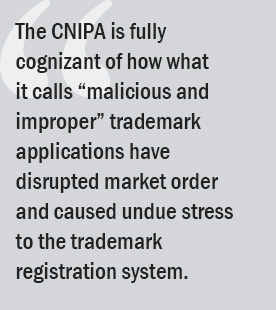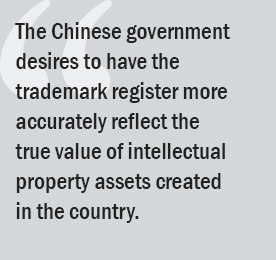Regulations Clarify Role of New Agencies Following China’s IP Institutional Reform
Published: November 1, 2018
Bai Gang Wanhuida Peksung IP Group Beijing, China
 Since the Chinese government announced its plan to reorganize various government agencies in March, foreign brand owners have been wondering how it will affect the intellectual property (IP) sector and practice.
Since the Chinese government announced its plan to reorganize various government agencies in March, foreign brand owners have been wondering how it will affect the intellectual property (IP) sector and practice.
At the same time, the activities of the SAIC (trademarks and competition); SIPO (patents); the General Administration of Quality Supervision, Inspection and Quarantine (AQSIQ) (product quality); and food and drugs regulation were regrouped under one central administration, the State Administration for Market Regulation (SAMR). Zhang Mao, ex-Commissioner of the SAIC was appointed as Commissioner of the SAMR.
On September 10, 2018, the “Regulations on the Function, Organisational Structure and Staffing of the State Administration for Market Regulation” (SAMR Regulations) were released and came into force retroactively on July 30. On September 11, 2018, the “Regulations on the Function, Organisational Structure and Staffing of the National Intellectual Property Administration” (CNIPA Regulations) were released and came into force retroactively on August 1.
SAMR Regulations
The SAMR Regulations outline the following IP rights (IPR)-related functions:
- Market Regulation Enforcement: overseeing the integration and building of enforcement teams at local Administration for Market Regulation (AMR) offices; promoting integrated market supervision; and orchestrating major enforcement programs;
- Anti-Monopoly Enforcement: coordinating and promoting the execution of competition policy; overseeing fair competition probe; conducting anti-monopoly probe against concentration of operators, as well as anti-monopoly enforcement against monopoly agreement, abuse of market dominance position, and abuse of administrative power in eliminating or restricting competition; and coaching Chinese businesses in coping with overseas anti-monopoly suits; and
- Administration of Market Order: supervising and regulating market transactions, Internet commodity trading and the services thereof; organizing and overseeing the enforcement against pricing offenses or violations, unfair competition, illegitimate pyramid scheme or multi-level marketing, trademark or patent infringement, manufacturing or sale of counterfeits or shoddy goods; and supervising advertising industry and advertising activities.
These functions are expected to be fulfilled by the agency’s bureaus: the Enforcement Inspection Bureau, the Anti-Monopoly Bureau, the Internet Transaction Administration Bureau, the Price Probe & Anti-Unfair Competition Bureau, and the Advertising Administration Bureau.
According to the regulation, the Enforcement Inspection Bureau is tasked to organize and oversee investigations and enforcement against major cases of national implication or which have trans-provincial/municipal geographical reaching. Brand owners are advised to approach the Bureau if they seek to initiate nationwide or trans-provincial/municipal enforcement actions.
IPR enforcement against trademark or patent infringement, counterfeiting, and unfair competition also falls under the jurisdiction of the Enforcement Inspection Bureau, but given the top-down nature of the institutional reorganization, a nationwide AMR network has not yet been formed. For instance, there is no Beijing AMR yet. This could be problematic. The IPR enforcement function of the CNIPA and local IP offices (IPOs) has been de facto transferred to the SAMR and its local offices. However, in the regions where there is no local AMR, brand owners will need to resort to the local IPO and the Market Supervision and Administration Office (equivalent to the local Administration of Industry and Commerce) with respect to functions) to enforce their IPRs.
The Anti-Monopoly Bureau, integrating the Anti-monopoly Bureau of the Ministry of Commerce (MOC), the Price Supervision and Inspection and Anti-monopoly Bureau of the National Development and Reform Commission (NDRC), and the SAIC’s Anti-monopoly and Anti-unfair Competition Enforcement Bureau, will be the nation’s anti-monopoly watchdog, acting as the executive organ of the Anti-monopoly Committee of the State Council.
CNIPA Regulations
The CNIPA Regulations outline, inter alia, the following functions, among others:
- Drafting and Execution of National IPR Strategy: formulating major policies, initiatives, and developing plans for building China into an IP powerhouse; and developing and executing administrative policies and mechanism to promote IP innovation, protection, and utilization;
- IPR Protection: devising and implementing protection mechanisms for trademark, patent, geographical indications (GIs), and layout design of integrated circuits; drafting laws, regulations, and departmental rules, and overseeing the execution thereof; and overseeing trademark and patent enforcement and supervising IP dispute resolution, enforcement aid, and dispute mediation at local levels; and
- Examination, Registration, and Administrative Adjudication of IPR: trademark registration, patent examination, and registration of layout design of integrated circuits; re-examination, invalidation, and other administrative adjudication of trademarks, patents, and layout design of integrated circuits; as well as the drafting and execution of integrated GI assessment mechanisms.
The CNIPA Regulations explicitly task the agency to shorten the IP registration cycle and to enhance examination quality and efficiency, as well as to focus on trademark bad faith filings and unproductive patent applications.
 Given that the China Trademark Office (CTMO) and the Trademark Review and Adjudication Board (TRAB) have been incorporated into the CNIPA, the application and granting of trademarks, patents, layout designs of integrated circuits, and GIs is under the independent governance of the CNIPA.
Given that the China Trademark Office (CTMO) and the Trademark Review and Adjudication Board (TRAB) have been incorporated into the CNIPA, the application and granting of trademarks, patents, layout designs of integrated circuits, and GIs is under the independent governance of the CNIPA.
Most importantly, the documents address the division of labor between the SAMR and the CNIPA with respect to IPR enforcement:
The SAMR organises and oversees trademark and patent enforcement.
The CNIPA coaches the trademark and patent enforcement practice, sets criteria for the affirmation of trademark and patent rights and for the ascertaining of trademark and patent infringement and oversees the execution thereof, as well as sets parameters for the inspection, authentication and other practices in trademark and patent enforcement.
It seems that the CNIPA is expected to devise a set of criteria and practice manuals on IP infringement, which the SAMR will be executing in its enforcement actions.
The CNIPA Regulations also contain a brief and very vague mention of copyright, which reads, “Copyright administration shall be in compliance with the regulations on the division of labor promulgated by the Central Committee of China Communist Party and the State Council.” It remains to be seen whether the SCOPSR will release a similar document on the National Copyright Administration in the near future.
INTA’s China Representative Office based in Shanghai represents the Association’s 269 members in China. Working in collaboration with staff at INTA’s headquarters in New York City, the China Representative Office leads the Association’s policy, membership, marketing, and communications initiatives in these jurisdictions. To learn more about INTA’s activities in China, please contact INTA Representative Officer, Shanghai, Monica Su, at [email protected].
Although every effort has been made to verify the accuracy of items in the INTA Bulletin, readers are urged to check independently on matters of specific concern or interest. Law & Practice updates are published without comment from INTA except where it has taken an official position.
© 2018 International Trademark Association
This website uses cookies so that we can provide you with the best user experience possible. Cookie information is stored in your browser and performs functions such as recognising you when you return to our website and helping our team to understand which sections of the website you find most interesting and useful.
To find out more please see our Cookies Policy and Privacy Policy.
These cookies are used to identify a user’s browser as the visitor goes from page to page on the Site. These are session cookies, which means that the cookie is deleted when you leave the Site. It is an integral piece of the Site software and used to let the server know which users are on the Site at any given time and make certain parts of the Site easier to use.
|
|
If you disable this cookie, we will not be able to save your preferences. This means that every time you visit this website you will need to enable or disable cookies again.
These cookies are used to collect information about how visitors use our Site. The cookies collect information in anonymous form, including the numbers of visitors to the Site, where visitors have come to the Site from, the pages they visited and how they have interacted with tools on the Site like search and embedded media players. We use the information to compile statistical reports of our users’ browsing patterns so that we can improve the Site.
|
|
Please enable Functionality Cookies first so that we can save your preferences!
These cookies are used to deliver advertising relevant to the interests of visitors to our Site. They are persistent, which means they will remain on your device after you leave the Site.
- Facebook (Ad Pixel)
- Google (Ad Pixel)
- LinkedIn (Ad Pixel)
- Quattro Anonymous
Please enable Functionality Cookies first so that we can save your preferences!
